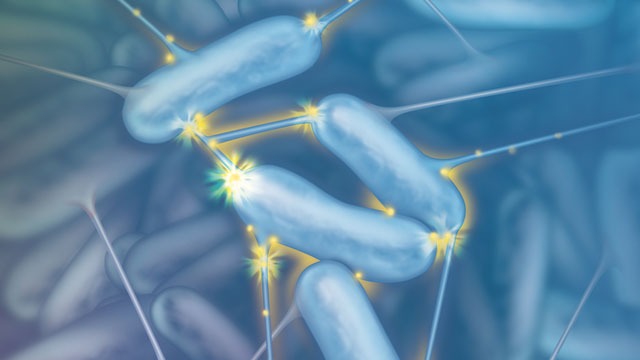Iron Cycle
The iron cycle features the interchange of ferrous iron (Fe2+) to ferric iron (Fe3+). In environments that are fully aerated with a neutral pH, iron is present primarily as insoluble minerals of either oxidation state. The solubility of both reduced, ferrous iron (Fe2+) and oxidized, ferric iron (Fe3+) increases with acidification, so that below pH4, iron is found in the aqueous form. Its assimilation presents two challenges for most aerobic microorganisms.

First, while iron is an essential element, free iron is usually present in very small quantities. Second, Fe3+ dominates in oxic environments, but microbes generally incorporate Fe2+ into biomolecules such as enzymes involved in redox reactions. The use of siderophores solves both problems. Siderophores are low molecular weight organic molecules that bind Fe3+, facilitating its transport into the cell, where it is reduced to Fe2+.
Dissimilatory reduction occurs when ferric iron serves as a terminal electron acceptor during anaerobic respiration. In most environments, Fe3+ is found chiefly in a crystalline phase (e.g., hematite and magnetite) and as a component of sediment clays.
Recent studies have shown that some microbes can donate electrons from the electron transport chain to these solid forms of Fe3+ outside the cell. Different microbes appear to use different strategies to transfer electrons to these external electron acceptors.
For instance, δ-proteobacteria in the genus Geobacter and γ-proteobacteria in the genus Shewanella use electrically conductive pilus like structures called nanowires to transfer electrons from a reductase in the outer membrane to particulate Fe3+. Shewanella spp. also produce redox-active flavins that shuttle electrons from the outer membrane to crystalline Fe3+ oxides.

A wide range of bacteria and archaea are capable of dissimilatory Fe3+ reduction. This includes genera from Euryarchaeota and Crenarchaeota, all five classes of Proteobacteria, Firmicutes, Deferribacteraceae, Acidobacteria, Thermotoga, and Thermus. This phylogenetic diversity may reflect the antiquity of FeH reduction. It is believed that early life began 3.5 billion to 3.8 billion years ago in an environment that was rich in Fe2+.
The photooxidation of Fe2+ to Fe3+ and H2 would have provided an electron acceptor and energy source, respectively, to early cellular forms. Banded iron formation that occurred when atmospheric oxygen levels were beginning to increase at the end of the Precambrian era may be evidence of increased bacterial iron metabolism.
In addition to ferric iron (Fe3+) as a terminal electron acceptor, some magnetotactic bacteria such as Aquaspirillum magnetotacticum transform extracellular iron to the mixed valence iron oxide mineral magnetite (Fe3O4) and construct intracellular magnetic compasses.
Magnetotactic bacteria may be described as magnetoaerotactic bacteria because they are thought to use magnetic fields to migrate to the position in a bog or swamp where the oxygen level best meets their needs. Furthermore, some dissimilatory iron-reducing bacteria accumulate magnetite as an extracellular product.

Ferrous iron (Fe2+) can be used as an electron donor by lithotrophic microbes in acidic, oxic environments where Fe2+ is soluble and oxygen can serve as the terminal electron acceptor. This has been well characterized in the β-proteobacterium Acidithiobacillus ferrooxidans and thermophilic crenarchaeotes in the genus Sulfolobus.
In addition, it is now known that a number of microbes oxidize Fe2+ at neutral pH under oxic conditions. Best studied are γ-proteobacteria in the genus Marinobacter and β-proteobacteria in the genera Leptothrix and Gallionella.
Ferrous iron can also be oxidized under anoxic conditions with nitrate as the electron acceptor. One interesting anaerobic microbe is Dechlorosoma suillum, which oxidizes Fe2+ using perchlorate (ClO4–) and chlorate (ClO3–) as electron acceptors. Because perchlorate is a major component of explosives and rocket propellants, it is a frequent contaminant at retired munitions facilities and military bases.
Thus D. suillum may be used in the bioremediation (biological cleanup) of such sites. This process also occurs in aquatic sediments with depressed levels of oxygen and may be another route by which large zones of oxidized iron have accumulated in environments with lower oxygen levels.
Reference and sources
- https://www.researchgate.net/publication/264938440_Electroactive_bacteria-molecular_mechanisms_and_genetic_tools
- https://www.slideshare.net/tamilsilambarasan/sulphur-cycle
- https://www.researchgate.net/publication/11020069_Evidence_for_rapid_microscale_bacterial_redox_cycling_of_iron_in_circumneutral_environments
Also Read:
- Microbial Fuel Cells
- Types of microscopes
- The Genetic Code
- Agglutination reaction: Definition, Uses and Application
- Microscopy: Overview, Principles and Its Types
- Bacteriophage: characteristics and replication of lytic and lysogenic cycle
- AIDS: Acquired Immune Deficiency Syndrome
- Immunoglobulin: Introduction, Structure and function
- Cider: Production, Extraction, Fermentation and Maturation
